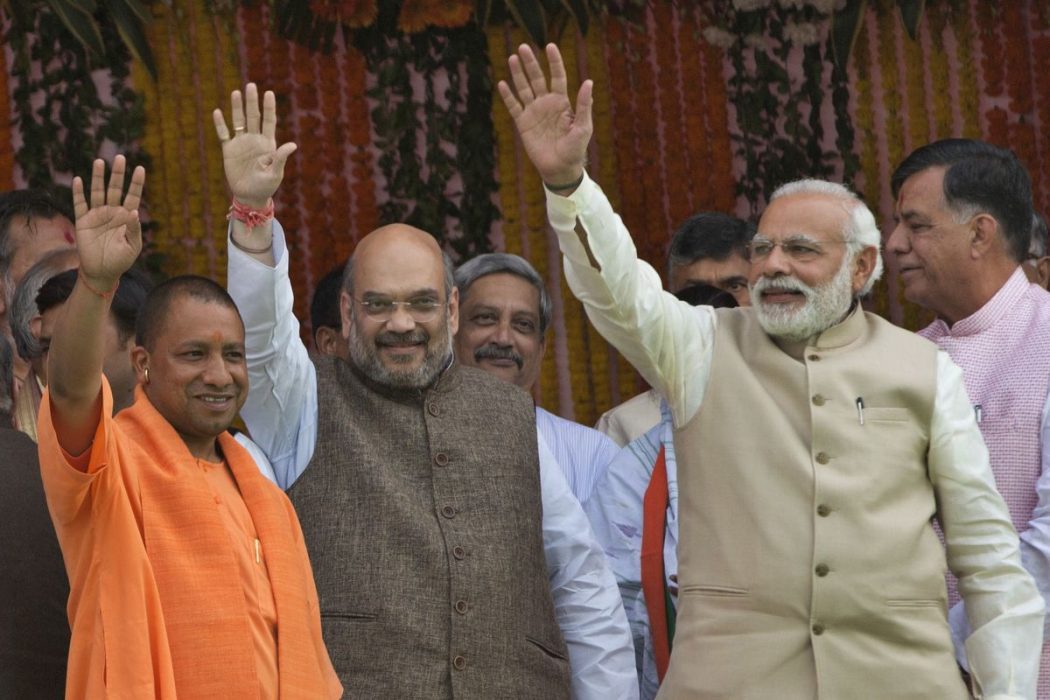While Modi came into power riding the wave of “sabka saath, sabka vikas”, Yogi seems to be coming from a very pre-modern sense of violence, which exists only to destroy. This difference is very important according to Soumabrata Chatterjee.
As of this week, Jawaharlal Nehru University has declared the admission seats for the upcoming academic year. There has been a massive cut of seats and my own center (English studies) does not have any vacancies in the coming year. The recently concluded Uttar Pradesh elections have strengthened the Hindu right and Yogi Adityanath has been selected as the numero uno in the political framework. Most of us thought and prayed and hoped that this wouldn’t happen. But it has. And as my own campus gets more divided based on the sudden demise of a Dalit student J. Muthukrishnan, we struggle to keep track of the changing political dynamics in this micro-region of India. Some suggest that it is an institutional murder and there have been anecdotal evidence to suggest rampant casteism in the center of Historical studies that Muthu represented. Some take the path of suggesting that this is a suicide, which has been fuelled by the general apathy towards marginalised communities and people by the JNU administration and the political powers that lie beyond it. In a moment of introspection, however, we realise that we have failed to create an environment of inclusiveness where identity is not just a fossilised piece of evidence but rather something, which sparks off debates and cultural discussion. We have failed not only to listen, and talk more appropriately but also to check our own casteist privileges as we keep on debating, and writing, and researching.Some suggest that it is an institutional murder and there have been anecdotal evidence to suggest rampant casteism in the center of Historical studies that Muthu represented. Some take the path of suggesting that this is a suicide, which has been fuelled by the general apathy towards marginalised communities and people by the JNU administration and the political powers that lies beyond it.
The idea of the outsider is impinging on our popular consciousness now. And that is true for most people in this university and outside. We keep talking of inclusiveness and equality and yet every time we turn to a familiar state machinery to make arguments against caste prejudice, Islamophobia, and sexism. These three instances of controlling and producing hatred for the ‘other’ is not just a derivative of some external power that has been ruling us. It is we, the people of India, who have through a ‘secular’ (if you say so), ‘democratic’ (if you say so) and ‘legal’ (if you say so) process appointed this giant of a party, which is now intent on ruling through division. However, I wonder if this is a new variant of ‘divide and conquer’ because after a point you understand that nobody is conquering anything really.
If you take a mental picture of Hindu right-dom and try to connect the dots from the earliest nationalistic fervour of Bankim Chandra, Vivekananda, then Golwalkar and the Babri demolition and the 90s which saw the Ramjanmabhoomi movement and then this resurgence of BJP and Modi, you would realise that the dots do connect but only vaguely so. This time a popular slogan came around the corner, “UP mein rehna hai toh Yogi Yogi kehna hai.” Just note the semantic significance of this statement and then compare it to Modi’s ‘Acche din’ campaign. While Modi came into power riding the wave of “sabka saath, sabka vikas”, Yogi seems to be coming from a very pre-modern sense of violence, which exists only to destroy. This difference is very important according to me.
Modi’s charisma, his 56-inch chest, his speeches and his smooth talking brought in a new form of public figuration. “Somebody who could get things done”. An autowallah from Uttar Pradesh once told me that he loves Modi simply because “dekho, bhasa uski humare bohot kareeb hai. Aur asli mard insaan hai!” Even though the Gujarat Modi might have been a part of that culture of masculinity which is pernicious to anything without his religious, caste and gender identity, this Modi simply is somebody who has become a household name running the dream of togetherness as opposed to the upper echelons of Congress and Samajwadi Party which seems to be elitist and ensconced in a politics of “man talking to men”. The whole marketing gimmick behind the use of the word ‘mitron’ is something, which always already includes the listener and creates a form of understanding. All of this and much more are of course just marketing strategies and branding exercises but it works very well as of now. Yogiji, on the other hand, seems to be content in an episode of ‘Aap ki Adalat’, to reiterate “as sanyasis, we have a mala in one hand and a bhalla in one hand. We are taught scriptures as well as how to use weapons.” This, of course, came in the context of being asked why he declared unabashedly that the murder of a Hindu will not see a constitutional remedy but rather a violent answer by hurting and killing ten Muslims. After that he goes on to suggest that this is a “jungle raaj”.The whole marketing gimmick behind the use of the word ‘mitron’ is something, which always already includes the listener and creates a form of understanding. All of this and much more are of course just marketing strategies and branding exercises but it works very well as of now.
This was in 2014. And right now, in 2017 we can understand that Yogiji and Modi represent two very different forms of modernity and processes of acculturation. I am not suggesting that Modi believes in inclusiveness but he certainly makes people believe that.
This was in 2014. And right now, in 2017 we can understand that Yogiji and Modi represent two very different forms of modernity and processes of acculturation. I am not suggesting that Modi believes in inclusiveness but he certainly makes people believe that. We need to realise the fissures of this political bond if we have to defeat the fascistic tendencies of the present government. Gone are the days when moderates smooth-talked their way out of situations. Yogiji’s ascent to the throne reveals a different kind of politics, something that has been lurking around the corner for quite some time now. This politics, does not believe in masking itself, or ridding off the public glory and happiness that Modi seems to be happy serving to a half-drugged, half-drowsy, half-ragged nation. This militarisation of politics is almost happening at a molecular level with the disappearance of Najeeb, the institutional murder of Rohith Vemula, and the army-kisan binary, which is almost at the verge of defining who is a proper Indian.
After the 90s, when the floodgates opened and India discovered ‘newness’ within itself, and the Hindu right reared its head, we thought maybe it’s all done and dusted. We have seen it all. And yet here we are, witnessing another vivid change in the political ideology of being an Indian. I will have to leave this article open-ended with a quote, which was posted, on Youtube underneath the ‘Aap ki Adalat’ episode. It read, “Bahut ho gaya Modi Modi aagli baar Aditya Yogi”. Are we moving towards another Hindu right? Another definition of how Hinduness is Indianness?
Image via www.vox.com



pankaj karnwal
Nice article thanks for sharing with us.
Denise Carroll
This blog is so nice to me. I will keep on coming here again and again. Visit my link as well.. Steak Delivery Toronto